The traditional cuisine in Rhineland is characterized by simple and hearty dishes. The classics are heaven and earth, potato pancakes and sauerbraten. Agricultural products such as vegetables, potatoes and meat are the basis. The Rhenish cuisine is regionally different, the kitchens of the Bergisches Land and the Lower Rhine are known. The cities of Cologne, Düsseldorf, Bonn and Aachen have a special culinary position.
dishes
- Himmel un Ääd (heaven and earth). is a traditional Rhenish dish that gets its name from the ingredients: apple compote (apples from the sky) with mashed potatoes (potatoes from the earth) mixed. Fried black pudding or liver sausage with roasted onions is served with it.
- Suurbroode (sauerbraten). or Thrush. Connoisseurs prepare the Rhenish sauerbraten from horse meat (if available), today housewives usually eat beef. Marinating for several days makes the meat tender. The sauce is traditionally prepared with sugar beet syrup or apple cabbage to create the typical sweet and sour taste, regionally also with raisins. The sauce is bound with Aachener Printen or Lebkuchen. Traditionally it is served with potato dumplings and applesauce, today it is also served with boiled potatoes, pasta or red cabbage.
- Düsseldorf mustard roast. is a rump steak with a special mustard crust. Finely diced onions and mostly the Düsseldorf lion mustard are spread as a paste on the meat and then briefly gratinated.
Heaven and Earth
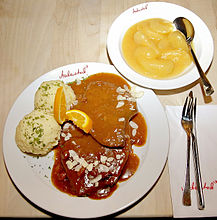
Sauerbraten

Düsseldorf mustard roast
- Hämchen met suure Kappes Translated means pork knuckle with sauerkraut
- Endive among each other
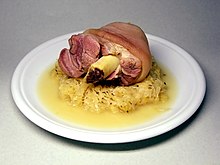
Hämchen met suure Kappes
Small dishes
- A Crumbs. actually stands for a bread crust, but it is also the expression for a schnitzel on a slice of rye bread, topped with a fried egg. But it can also serve as a small portion of goulash with Röggelchen Crusts warm or Crusty goulash be meant.
- Halve Hahn. is a thick slice of medieval Gouda cheese on a rye roll Röggelchen with onions and mustard - met Öllich un Mostard.
- Cologne caviar is called black pudding with onions, Flönz is the name of the blood sausage

Crumbs

Halve Hahn

Cologne caviar
- Rievkooche are a typical Rhenish potato specialty. The potato potato pancakes are traditionally eaten with apple compote or turnip tops or, more modern, with smoked salmon. Pill boiling are similar.

Rievkooche
Soups
- Ädäppelszupp - Potato soup
- Äzezupp - Pea soup
fish
- Hirrings tip met jellyfish men are cream herring with jacket potatoes. You won't just be in the carnival gladly eaten.
- Rhenish style mussels. are mussels that are cooked in a broth of onions, leeks, carrots and celery, spices and plenty of white wine. They are served with wine stock and vegetables and eaten with black bread and butter. Traditionally, a clam shell is used as a cutlery when eating, in order to pluck the clam meat from the shell.

Rhenish style mussels
Pastries
- Röggelchen. are dark rolls with a high proportion of rye flour. They are usually sold as double buns, i.e. in pairs. At the Halve HahnThe Röggelchen, the typical snack in the brewery, is used.
- Weckmann (mare guy). can be found at Martinsfest (November 11th) in almost every bakery and discounter. The pastry in the shape of a man with a clay pipe is baked from sweetened yeast dough. In other areas it is referred to as the mare's guy and is eaten in Advent or January or offered all year round.

Röggelchen
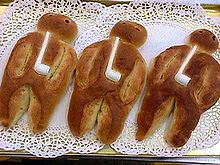
Weckmann
Sweets
- The most famous specialty in Bergisches Land is the Bergische coffee table. Its composition surprises the foreign visitor and makes it something special. The "caffeine-lowering with everything dröm on dran" differs from all comparable meals in the way it is put together. On a typical coffee table you will find yeast dough bread, usually with raisins, black and gray bread, sweet spread in the form of honey, pear, apple or beet cabbage, butter, quark, cheese, sausage and ham, rusks with icing, Rodon cake, rice pudding with Sugar and cinnamon, freshly baked cream wafers along with hot sour cherries and cream and, regionally, even scrambled eggs. The coffee flows out of one in proper style Dröppelmina, a bulbous tin can on three legs with a tap from which the coffee is made bobbed.
- Bergisch waffles are warm waffles with hot sour cherries and cream
- The Burger pretzel is a specialty from Burg an der Wupper, a district of Solingen
- Monschauer Dütchen are small, crunchy biscuits made from egg biscuits, which they made in Café Rur in 1853 Monschau were invented. They are filled with cream, ice cream and fruits, there are many options. Today you can try them in many Monschau pastry shops and cafés.
Bergische coffee table
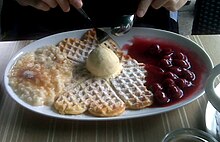
Bergisch waffles with rice pudding, cinnamon and sugar
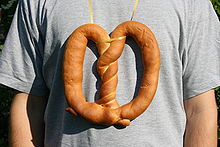
Burger pretzel
- Printen. are gingerbread that are baked in Aachen and are protected by the EU as a product. They are baked in different shapes and coated with chocolate or decorated with nuts and almonds. Herbal sprints are used in various hearty dishes to thicken the sauces and refine their taste.

Aachen herb print, chocolate print, cut chocolate print (from right)
- The 1 Imhoff Chocolate Museum in Cologne deals with all the details of the cultural history of chocolate. The history of the cocoa bean is shown in the museum and the industrial production of chocolate products can also be seen there, which can also be purchased in the museum shop.
ingredients
- Flönz. is a blood sausage, the name is also in Cologne Blootwoosch common. Flönz has been protected by the EU as a designation of origin since 2016. Small pieces of fat are added to the sausage meat and the sausage is lightly smoked. It is often eaten with beer in pubs and is also used in various dishes (see above).
mustard
- 1 Lion mustard. comes from Düsseldorf. The lion mustard extra (spicy) is known, but there are also Altbiersenf, fig mustard and other variations.
- in the 1 Düsseldorf mustard shop there is a large selection of mustard specialties, sauces and lion mustard fan articles.
- Düsseldorf Mostert. is also called ABB mustard. It is a Düsseldorf mustard that has been produced since the 18th century. The origin is EU protected.
- in the 2 Gewürzhaus old town there are spices from anise to cinnamon, as well as the well-known Düsseldorf ABB Mostert and other types of mustard.
- The 2 Cologne Mustard Museum shows exhibits on the history of spices in a historic mustard mill from 1810. The focus is on the sale of high-quality mustard products.
beverages
Wine
in the Siebengebirge Wine is grown on the Drachenfels. In terms of wine geography, the vineyards on the Drachenfels belong to the Middle Rhine wine-growing region.
- The 1 Blöser winery in Koenigswinter
- The 2 Pieper winery in Koenigswinter
- The 3 Broel winery in Bad Honnef
beer
Pils are drunk almost everywhere, but Kölsch is preferred in the Cologne area, and Altbier in the Lower Rhine and in the region around Düsseldorf. The invisible Kölsch-Alt border should go through Dormagen to run. A small Monheim brewery even has that Költ developed, a mixture of Kölsch and Alt.
- Altbier. is a dark, top-fermented beer. The market leader is the Diebels brewery in Issum on the Lower Rhine.
- Kölsch. is a light full beer that has to be brewed in Cologne and the surrounding area. Kölsch has been protected since 1985, only around 24 breweries in and around Cologne are allowed to call their beer Kölsch.
- The How or that Wijss beer are the predecessors of Kölsch. Like Kölsch, it is brewed top-fermented, but is unfiltered and naturally cloudy.
- As Krefelder the mixture of Altbier with Cola is called. It is now established and is also marketed ready-mixed in bottles.
- At Old shot Altbier is mixed with malt beer.
- Altbierbowle (Old plus strawberries or other fruits) is even well received in Münster (Westphalia)

Dark alt
Light Kölsch
Schnapps and liqueurs
- A traditional culinary specialty in Siegburg is the Abbey liqueur. The herbal liqueur was made by the monks of Michaelsberg Abbey until 2011; today it was taken over by a company. You can taste and buy it directly in the liqueur cellar on the Michaelsberg. It is also possible to buy the liqueur around the clock at the reception in the Kranz Parkhotel in Siegburger Mühlenstraße.
- Killepitsch. is a bitter-sweet herbal liqueur Dusseldorfwho has since made friends around the world. A mixture of 98 different herbs, berries and fruits from all over the world are stored in old clay vessels for a year and then processed with alcohol, water, sugar and caramel to make the finished liqueur with 42% alcohol.
- The 4 Et Kabüffke in Dusseldorf is a small, rustic Killepitsch tasting room. Besides the liqueur, you can also drink wine.
Siegburg Abbey Liqueur

Killepitsch
coffee

Emmerich on the Rhine is the coffee town in the Rhineland. Not only they have there Probat works, The world market leader for coffee roasting machines, has its headquarters there, and the oldest German coffee roasting company that still exists since 1832 Lensing & van Gülpen. Top coffees are slowly roasted in the manufactory in a 90 kg Probat drum roaster built eighty years ago or in the smaller 12 kg Probat drum roaster. They can be found nationwide in delicatessen stores or online in the roaster's web shop or - not fresher, but more expensive - at Manufactum available. In Emmerich you can buy van Gülpen coffees at Panciera to buy. In Probat's own Museum of Coffee Technology groups of visitors can be shown the history of coffee roasting.
Soft drinks
Culinary calendar
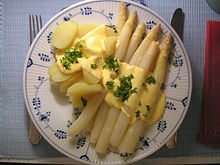


Culinary delights are often seasonal. Fruits and vegetables are tastier when they are ripe; meat and fish are also subject to seasonal influences. Every season of the year, festivals are celebrated that have a general theme or focus on certain foods. There are also drinking and eating habits throughout the year that arose from religious traditions such as fasting times.
January
February
- There's carnival Bollebäuskes, sweet dough portions with raisins baked spoon by spoon in fat, which are then sprinkled with sugar or cinnamon sugar and consumed warm.
March
April
- From April to November (except August) takes place on the first Sunday of the month fish market, on the Rheinterrassen, Tonhallenufer, Düsseldorf. with international fish and sea specialties.
- The Asparagus season begins, depending on the soil temperature, with asparagus spears from heated fields at the beginning of April
- Traditionally on April 23rd the Day of the beer celebrated, because on this day in 1516 the German purity law was proclaimed. There are events on the topic of beer in many places (German Brewers Association).
- End of April: end of the traditional Mussel season (Note: every month with "r")
May
- Rhubarb season
- First Sunday: fish market, Düsseldorf
- Asparagus season. Now the asparagus comes from film tunnels and from the field. Farmer's wisdom: "Don't forget until Midsummer: Eat asparagus for seven weeks!"
June
- First Sunday: fish market, Düsseldorf
- High season for local people Strawberries. Now they are not only red, but also ripe, sweet and juicy.
- On Midsummer Day, June 24th ("Asparagus New Year"), the season ends for asparagus and rhubarb. Perennial plants need time to recover, and the potentially unhealthy levels of oxalic acid in the rhubarb stalks increase.
July
- First Sunday: fish market, Düsseldorf
August
September
- First Sunday: fish market, Düsseldorf
- Beginning of September: beginning of the traditional Mussel season (Note: every month with "r")
October
- First Sunday: fish market, Düsseldorf
November
- First Sunday: fish market, Düsseldorf
- For Martinsfest on November 11th, you can go to almost every bakery Wake-up men to buy
- St. Martin is also used in many restaurants Martin goose offered.
December
literature
- Willi Drecksträter: Delicious dishes from the old Rhineland cuisine. Comet, Cologne, ISBN 3-933366-21-6
Recipes
If you want to enjoy Rhenish cuisine at home, you can find the corresponding recipes in the Koch-Wiki Category: Rhenish cuisine. Have fun cooking at home.





























